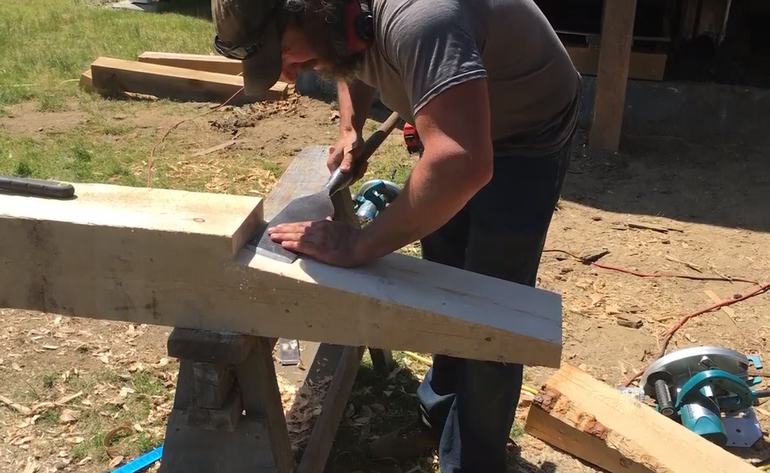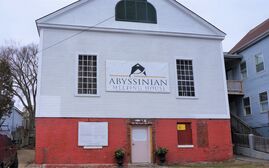
Study will guide Maine historic preservation development, big and small
 Courtesy / Belgrade Historical Society
A carpenter works on restoration of the Belgrade Town House. One need in the state is for more trades education for historic preservation work, those in the industry say.
Courtesy / Belgrade Historical Society
A carpenter works on restoration of the Belgrade Town House. One need in the state is for more trades education for historic preservation work, those in the industry say.
A study underway by the Maine Historic Preservation Commission, partnering with several other organizations, will be used over the next five years to help guide the direction of preservation development in the state.
The study is required every five years by the National Park Service, and is used by the the state historic preservation office and others throughout Maine to guide decision-making, activities and more.
But the plan is not an office management plan for the state preservation commission, said Christi Chapman-Mitchell, assistant director of the commission. "It's a way to take the temperature across the state," she said.
Once done, the report generated by the information-gathering process summarizes opportunities and challenges for preserving and promoting historic places in the state, and lays out a vision for what the preservation community will be working toward over the next five years. It's a way to engage the public more in the process, and offer resources for preservation, organizers said.
Findings of the study — which includes an online survey open for anyone to take, a series of listening sessions and more — can be used by everyone from small towns pursuing small preservation projects, to professionals in the field who make their money from historic preservation, to organizations that offer grants and support for preservation, to developers.
The state commission oversees a variety of historic preservation projects, including the National Register of Historic Places for the state. That listing is necessary for developers to get Historic Preservation Tax Credits, a program that has generated $166 million in local property taxes across the state, according to a study released last month by Maine Preservation.
But the state commission's work, and the study, also guide a large variety of preservation efforts in Maine.
For instance, Yarmouth is in process of creating a historic preservation ordinance, one of the last steps toward getting certified local government status with the National Park Service, which opens up resources for historic preservation. The town has been working toward that since its 2010 comprehensive plan was drawn up.
Other projects that come under the state Historic Preservation Commission umbrella range from the Kennebunkport Conservation Trust pursuing an archeological survey, to Bangor updating its historic building survey.

Preservation's wide scope
Chapman-Mitchell said that the scope of historic preservation in the state goes well beyond what the state commission does, and the results of the study are for everyone who has a stake in historic preservation in Maine to use.
The study was originally due for National Park Service review this month, but the state got a one-year extension because of the COVID-19 pandemic. Original plans had been to hold public meetings in historic properties across the state, but that was scrapped in favor of a series of Zoom listening sessions that ended this week. Those were done in partnerships with the Maine Development Foundation, Maine Downtown Centers, Maine Preservation Greater Portland Landmarks, the city of Bangor, Acadia National Park and the St. Croix Island International Historic Site.
The variety of groups involved in the listening sessions is indicative of the wide range of people, organizations, municipalities and agencies that comprise Maine’s preservation community, organizers said.
The online survey is available through the end of the year, and the report will likely be ready for the National Park Service to review by late spring, said Elizabeth Muzzey, a consultant who's helping with the survey effort. Muzzey said there's been a good response to the survey so far, but organizers of the study are hoping to get as many responses from as much of a variety of people as possible.
She said that results already show the breadth of the interest in historic preservation across Maine.
"There are so many people where it's their passion, and they spend years working on projects they feel passionate about," she said. She said that the last question, which asks those completing the survey what they expect to be doing regarding historic preservation over the next five years has already elicited a large amount of response.
"There is strong, strong support for historic preservation and historic planning," she said. "People feel very strongly about it."

Yarmouth pursues historic preservation ordinance
The Yarmouth Historic Preservation Ordinance is a good example of how the process can work, Chapman-Mitchell said. The ordinance is a major step to becoming a National Park Service Certified Local Government, which opens up resources and grant money for the town. There are 10 in Maine.
Yarmouth has been working on the ordinance for several years, and got a $12,000 Historic Preservation Fund Grant grant last year for the second phase of its preservation ordinance initiative to document and protect the historic architectural resources in the town.
The project is managed by Yarmouth Department of Planning and Development, with cooperation by the Yarmouth Historical Society and the Village Improvement Society. The draft of the historic preservation ordinance, which has to be approved by the town council, lays out the regulations and incentive-based measures to recognize, preserve and enhance the community's significant historic resources.
There are 10 Certified Local Governments in Maine — Portland, Bangor, Augusta, Lewiston, York, Gardiner, Topsham, Castine, Kennebunk and Saco. The next steps for Yarmouth to join that group are to approve the ordinance; create a preservation commission to oversee the ordinance and the program; provide for public education and participation, including nomination of properties to the National Register of Historic Places; conduct and maintain a survey and inventory of historic properties.
The state commission has to make 10% of its federal funding — about $80,000 — available to the certified towns and cities, Chapman-Mitchell said. "We have to give that money away," she said.
Grants this year from the funding included two to Portland, totaling $35,576, for digital mapping of Fort Gorges and historic preservation program manager support; $7,080 to Castine for a Fort George historic property management plan, and $28,000 to Bangor to update its historic buildings survey.

'A great time to be writing our next plan'
A town, organization, or even an individual, doesn't have to be pursuing that type of project to make use of the study, though.
"Someone says, 'I've got an old house and I wonder if its historically significant.'" The study guides them to local resources to help them find that information, or professionals they can work with.
Both Muzzey and Chapman-Mitchell said that public input is crucial to the study.
"We want to hear about successes, were we want to be heading," Chapman-Mitchell said. "There are a lot of small towns, with small properties, there are professionals who make their money from historic preservation, there are agencies that have to take historic preservation into account."
The survey asks questions that allow those taking it things like what kind of historic properties define Maine, which ones they feel are most endangered, as well as questions about funding and technical issues.
Even though information is still being gathered, some universal concerns have emerged. A major one is money.
"Funding is always an issue," said Chapman-Mitchell. "There's never enough money. That doesn't change."
She said another issue is lack of education programs in the state for historic preservation careers and trades, like woodworking and masonry with a focus on historic rehabilitation.
Muzzey said other concerns are also a need for more public outreach and educational program about historic preservation, and also looking at preservation through the lens of climate change.
One big difference the new study will have that the one five years ago didn't is more inclusivity and diversity, Chapman-Mitchell said. "This is a great time to be writing our next plan," she said. As the plan offers guidance for the future, "I think that's important."

Something for every community
Historic preservation organizations in recent years have stressed the economic benefits of preservation development. The state's Historic Preservation Tax Credit program has added $166 million to local property tax rolls, including $17 million in new property tax payments, and has brought in $3 million more than what was paid out, a report released last month said.
Chapman-Mitchell said that the emphasis on the economic benefits, as well as the state beefing up its historic preservation tax credit program several years ago, has highlighted historic preservation in recent years. But preservation is about more than that.
"Every community values its historic properties," she said. "It's not just about the economic benefits, by any means." She said the value of place, and understanding where we came from is just as important.
"If you don't know where you came from, you don't know where you're going," she said.











0 Comments